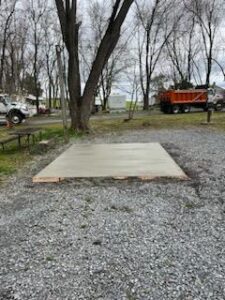Pothole Repair: Understanding the Problem
Pothole Repair are a common and frustrating problem that affects roadways in many cities, including Allentown. These are depressions or cavities that form on the surface of the asphalt, making driving uncomfortable and potentially damaging vehicles. Potholes are typically caused by a combination of factors, such as the freeze-thaw cycle, heavy traffic, and poor maintenance. Understanding the problem of potholes is essential to finding effective solutions and preventing further damage to our roads.
The formation of potholes usually begins with small cracks in the asphalt surface. When water seeps into these cracks and freezes, it expands, causing the cracks to widen. As traffic passes over these weakened areas, the asphalt starts to break down, eventually forming a pothole. In Allentown, the climate with its fluctuating temperatures and precipitation patterns can exacerbate this problem, increasing the frequency and severity of potholes on the roads. Understanding these common causes can help us identify the areas that are more prone to pothole formation and implement targeted strategies for repair and maintenance.
Common Causes of Pothole Repair in Allentown
Allentown, like many other cities, faces its fair share of potholes. These road hazards can cause significant damage to vehicles and pose safety risks to motorists. Understanding the common causes behind the formation of potholes can help city officials and road maintenance crews devise effective strategies to mitigate their occurrence.
One of the primary causes of potholes in Allentown is the freeze-thaw cycle that occurs during the winter months. When water seeps into cracks in the pavement and freezes, it expands, exerting pressure on the surrounding asphalt. As the ice melts, the pavement contracts, leaving behind gaps and weakened areas. With repeated freezing and thawing cycles, this process gradually weakens the pavement, eventually resulting in the formation of potholes. Additionally, the heavy traffic volume on Allentown’s roads can further stress the weakened pavement, accelerating the development of potholes.
• Freeze-thaw cycle during winter months
• Water seeping into cracks in pavement and freezing
• Expansion of ice exerts pressure on surrounding asphalt
• Melting of ice leaves behind gaps and weakened areas
• Repeated cycles weaken pavement, leading to potholes formation
• Heavy traffic volume further stresses weakened pavement
Signs to Look for in Damaged Asphalt Surfaces
Signs to Look for in Damaged Asphalt Surfaces
Cracks in the asphalt: One of the most common signs of a damaged asphalt surface is the presence of cracks. These cracks can occur due to a variety of reasons, such as age, heavy traffic, or weather conditions. They can start small, but if left unattended, they can expand and create bigger problems. It is important to regularly inspect your asphalt surface for any cracks, as early detection and repair can help prevent further damage and save you from costly repairs in the future.
Potholes: Another obvious sign of a damaged asphalt surface is the presence of potholes. Potholes are depressions or cavities in the road surface that develop when the asphalt weakens and breaks apart. They can be caused by a variety of factors, including freeze-thaw cycles, heavy traffic, and improper drainage. Potholes not only affect the aesthetics of the road but can also pose a safety hazard for vehicles, cyclists, and pedestrians. It is essential to promptly identify and fix potholes to maintain the integrity and functionality of the asphalt surface.
Effective Techniques for Pothole Detection
One effective technique for Pothole Repair detection is visual inspection. Taking the time to carefully examine the surface of roads and parking lots can help identify potential potholes before they become a bigger problem. Look for signs of cracking, crumbling, or unevenness in the asphalt, as these are often indicators of developing potholes. Additionally, pay attention to areas where water accumulation occurs, as trapped moisture can accelerate the formation of potholes.
Another technique for pothole detection is using technology, such as ground-penetrating radar (GPR) or infrared cameras. GPR can provide a detailed view of subsurface layers, allowing for the identification of weaknesses or gaps that may lead to potholes. Infrared cameras, on the other hand, can detect temperature variations in the asphalt, revealing areas of potential damage. By utilizing these advanced tools, transportation authorities and road maintenance crews can effectively locate and address potholes in a timely manner, minimizing the risk of accidents and further road deterioration.
Preventing Potholes: Essential Maintenance Practices
To prevent potholes and ensure the longevity of your asphalt surfaces, implementing essential maintenance practices is crucial. Regular cleaning and debris removal are paramount in preventing the formation of potholes. The accumulation of dirt, leaves, and other debris can trap moisture, which leads to the expansion and contraction of the underlying layers, causing the formation of potholes. By keeping the surface clean, you can reduce the risk of pothole development.
Additionally, proper drainage is vital in preventing potholes. Adequate drainage systems help to divert water away from the asphalt surface, minimizing the chances of water pooling and seeping into the underlying layers. Poor drainage can weaken the pavement structure and lead to the deterioration of the asphalt, making it more susceptible to potholes. By ensuring proper grading and maintaining drainage systems, you can effectively prevent potholes and extend the life of your asphalt surfaces.
Choosing the Right Materials for Pothole Repair
Choosing the right materials for pothole repair is crucial in ensuring effective and long-lasting results. One of the most commonly used materials for repairing potholes is asphalt patching. This material is advantageous due to its durability and ability to withstand heavy traffic. When choosing asphalt patching materials, it is important to consider the temperature in Allentown, as the climate can affect the effectiveness of the repair. Additionally, the size and depth of the pothole should be taken into account when selecting the appropriate asphalt patching material.
Another material commonly used for pothole repair is cold patch asphalt. This material is quick and easy to apply, making it an attractive choice for minor pothole repairs. Cold patch asphalt does not require heating or mixing, which is advantageous for DIY repair projects. However, it is important to note that cold patch repairs may not be as durable as hot asphalt repairs. Therefore, the extent of the damage should be assessed before deciding on the appropriate material for pothole repair.
Choosing the right materials for pothole repair is a critical step toward maintaining safe and smooth road surfaces. Considering factors such as climate, size, and depth of the pothole can help determine the most suitable material for the repair project. Whether opting for durable asphalt patching or convenient cold patch asphalt, the right choice of materials ensures a successful and effective pothole repair.
Step-by-Step Guide to DIY Pothole Repair
Repairing potholes on your own can be a cost-effective solution that saves you time and money. The first step in DIY pothole repair is to start by cleaning the pothole. Remove any loose debris, dirt, and vegetation from the damaged area to ensure a smooth and durable repair. It’s crucial to have a clean and stable foundation before proceeding to the next step.
After cleaning the pothole, the next step is to fill it with a suitable patching material. Cold patch asphalt is commonly recommended for DIY repairs as it doesn’t require any heating and can be easily applied. Start by pouring the cold patch material directly into the pothole, slightly overfilling it to account for compaction. Use a tamper or the back of a shovel to compact the patch, ensuring a tight and solid bond with the existing pavement. Repeat the process until the pothole is completely filled and leveled with the surrounding surface.
Importance of Regular Asphalt Surface Inspections
Regular asphalt surface inspections are crucial in maintaining the longevity and functionality of roads and driveways. By conducting routine inspections, potential issues can be identified and addressed before they become more extensive and costly problems. These inspections provide a proactive approach to maintenance, ensuring the safety of drivers and pedestrians alike.
During an inspection, various aspects of the asphalt surface are assessed, including the presence of cracks, potholes, and unevenness. These issues not only detract from the aesthetic appeal of the pavement but also pose risks of accidents and damage to vehicles. By detecting and repairing these problems early on, the overall integrity of the asphalt is preserved, reducing the frequency and extent of future repairs. Moreover, regular inspections allow for quick identification of any signs of structural weakness or deterioration, preventing potential hazards and ensuring the long-term durability of the surface.
Why is it important to regularly inspect asphalt surfaces?
Regular inspections help identify any potential issues or damage to asphalt surfaces early on, allowing for prompt repairs and preventing further damage.
What are the common causes of potholes in Allentown?
Potholes in Allentown can be caused by various factors, including freeze-thaw cycles, heavy traffic, aging asphalt, and poor installation or maintenance practices.
What are some signs to look for in damaged asphalt surfaces?
Signs of damaged asphalt surfaces include potholes, cracks, uneven pavement, depressions or sinking areas, faded or worn-out markings, and water pooling.
How can potholes be detected effectively?
Pothole Repair can be detected using various techniques, including visual inspections, pavement distress surveys, ground-penetrating radar, and infrared scanning.
What are some essential maintenance practices to prevent potholes?
Essential maintenance practices to prevent potholes include regular cleaning, sealcoating to protect the surface, filling cracks promptly, and performing necessary repairs as soon as issues are identified.
How do I choose the right materials for pothole repair?
When choosing materials for pothole , factors to consider include the type and extent of damage, the expected traffic load, climate conditions, and the longevity and durability of the materials.
Can I perform DIY pothole repair?
Yes, with proper guidance and the right materials, you can perform DIY pothole repair. However, it is important to assess the severity of the damage and consult professionals if needed.
Why is regular asphalt surface inspection important?
Regular asphalt surface inspections are important to ensure the safety and longevity of the pavement, identify and address any issues promptly, and minimize the need for costly repairs or replacements in the long run.



